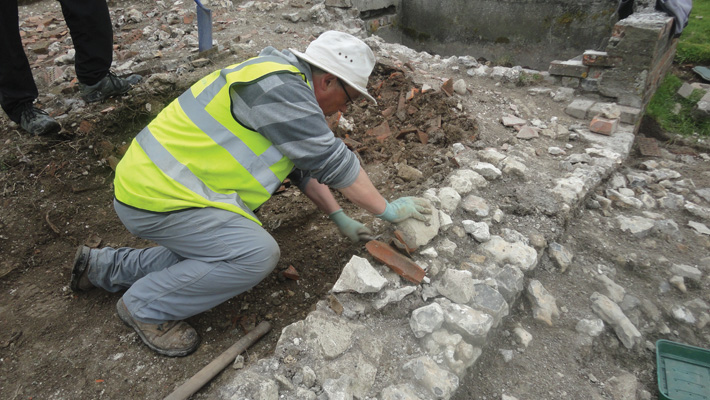The Dorset Diggers Community Archaeology Group was set up in 2012 to work in the community to facilitate the study of Dorset’s deeper past. That means that we are not just a hobby group, but to actively engage local communities in doing all aspects of research. Our first site was proof that archaeology does not always have to be about looking for aretfacts and structures from thousands of years ago, but also those that lived closer to our own time, now forgotten.
I was sitting in my village cafe in Maiden Newton when a villager came up to me and asked if I would be interested in looking at a structure up on the Drift Road/Old Sydling Lane. We walked there, whereupon I saw what looked like a water trough. From the trough a narrow mound of grass ran toward the hedge lining the lane. From the style of brick I thought that the structure was probably about one hundred years old, but still worth looking at. No one could say why this large structure was sitting in the field, as animals troughs are usually much smaller and connected to a water supply. We were asked to answer this question, so we set about digging.
We found that the mound was made up mostly of brick and tile and would need some serious hitting with mattocks to clear away. After that was cleared we had found a whole building, constructed from chalk and flint with the trough attached to it! The structure was divided into two rooms by another narrow chalk wall. The northern room had a brick wall on top of a flint foundation facing the lane, but this wall would not have been load-bearing and may have supported a timber partition that could have been opened to people using the path. The floor was divided into two parts, one cobbled and the other compacted earth. The cobbled flooring may have been the work area or as a hard standing for horses. The southern room had a compacted dirt floor, with a double door facing east. The finds made it highly probable that this was a small workshop dealing in metalworking relating to the repair of cart wheels and horse equipment.
The bricks were made by Colthurst & Symons & Co in the 1850s, leading brick makers in the Powerstock area. Metal waste comprised of nails, bars, hooks, brackets, door bolts and wheel rims. Two penknives had bone handles, the blades having corroded badly. A bridle bit with a twisted mouth piece was dated to the late 19th century or early 20th by a visiting horse rider who arrived within just a few minutes of the artefact being found! Bridle bits are now made smooth, as this is not so hard on the horse’s mouth.
A Camp Coffee bottle was found in perfect condition, embossed on three sides with “ESS CAMP COFFEE & CHICORY”, “GLASGOW”, “PATERSON”. Camp was founded in 1876, but the same design appears on adverts in the 1940s. A vet’s bottle was found close-by, intact, with a glass stopper. It was embossed “ELLIMAN’S ROYAL EMBROCATION FOR HORSES MANUFACTORY, SLOUGH” and is possibly late Victorian, but this was still being used in the early 1980s. It was for rheumatism, sore throat, sore shoulders and backs, capped hocks and elbows!
A glass stopper had the stamp WRIGHT & CO., based in Staffordshire. Further research was done on this company, the scene of an industrial accident where a glass kiln exploded. One worker was killed by the explosion and two others were killed by being engulfed in molten glass. Once the glass had cooled it was found that only hobnails and belt buckles had survived, so the remains were kept in glass blocks and then the whole buried. It was reported that the owner of the company told the men at the funeral that “they would have to work harder to make up for the loss of three employees”! However, the firm did not last long and went out of business soon after.
Archaeology is about our collective memory, in this case the structure we were excavating had been quickly forgotten, a structure that told a story of a local business much needed up to the time of the internal combustion engine took over the work of horses in the 20th century. Even though it was only a century since demolition it had been lost to us and the only way to recover that memory was to undertake an archaeological investigation. It can now be seen by a new generation.








